Article Review: Business Process Modelling and Process Architecture
VerifiedAdded on 2022/09/18
|25
|8452
|33
Report
AI Summary
This report presents an article review focusing on Business Process Modelling (BPM) and process architecture. The review analyzes two articles: the first explores the benefits and challenges of BPM, emphasizing its role in improving operational efficiency, process agility, and transparency. It also discusses the importance of strategic alignment between business and IT, security issues, and managing customer power. The second article delves into process architecture, describing it as a visual and hierarchical model that aids decision-makers in executing business strategies. It highlights the six core elements of process architecture: strategic alignment, governance, methods, information technology, people, and culture, along with their sub-elements. The review underscores the importance of these elements for successful business process execution and overall business strategy.
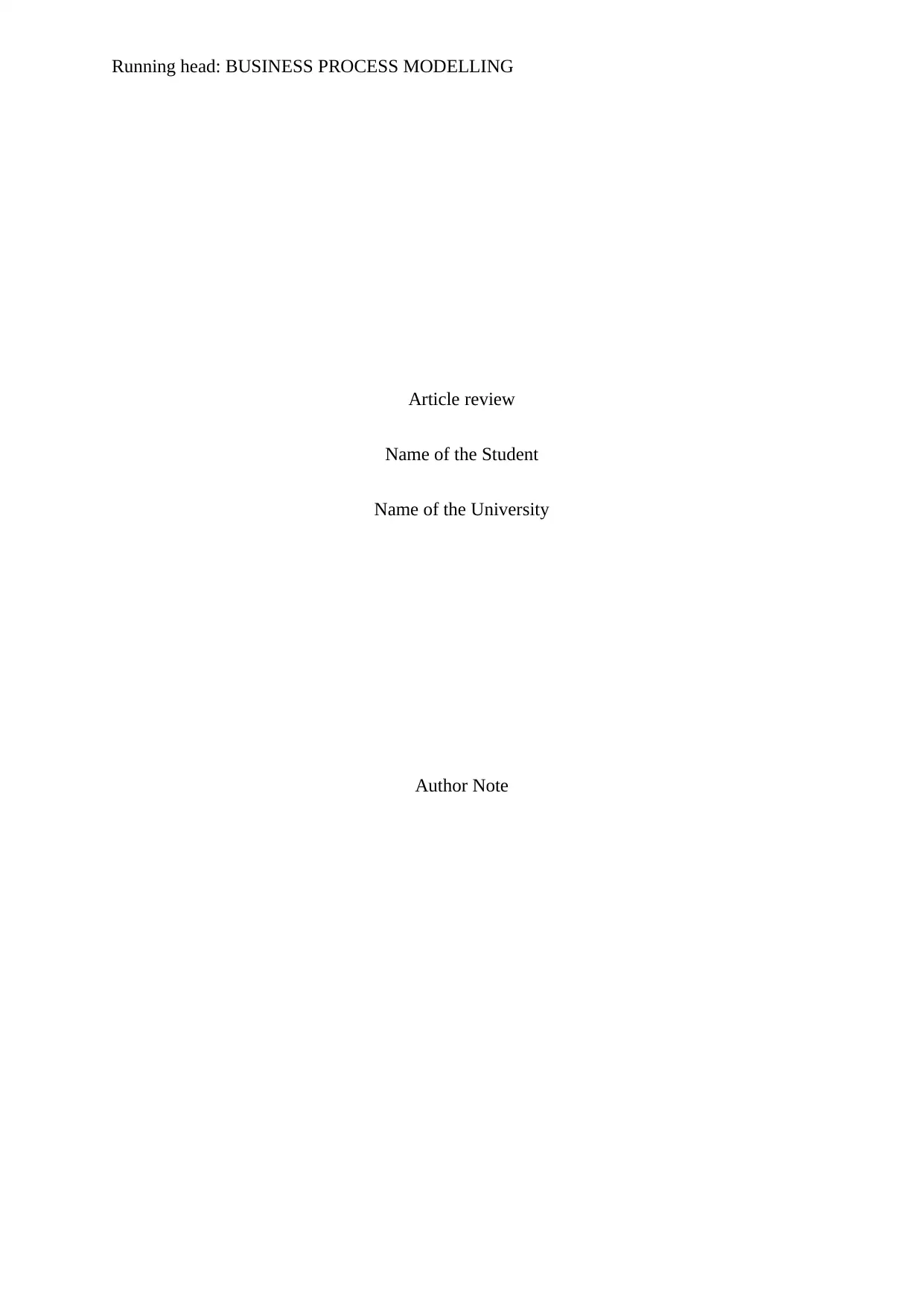
Running head: BUSINESS PROCESS MODELLING
Article review
Name of the Student
Name of the University
Author Note
Article review
Name of the Student
Name of the University
Author Note
Paraphrase This Document
Need a fresh take? Get an instant paraphrase of this document with our AI Paraphraser
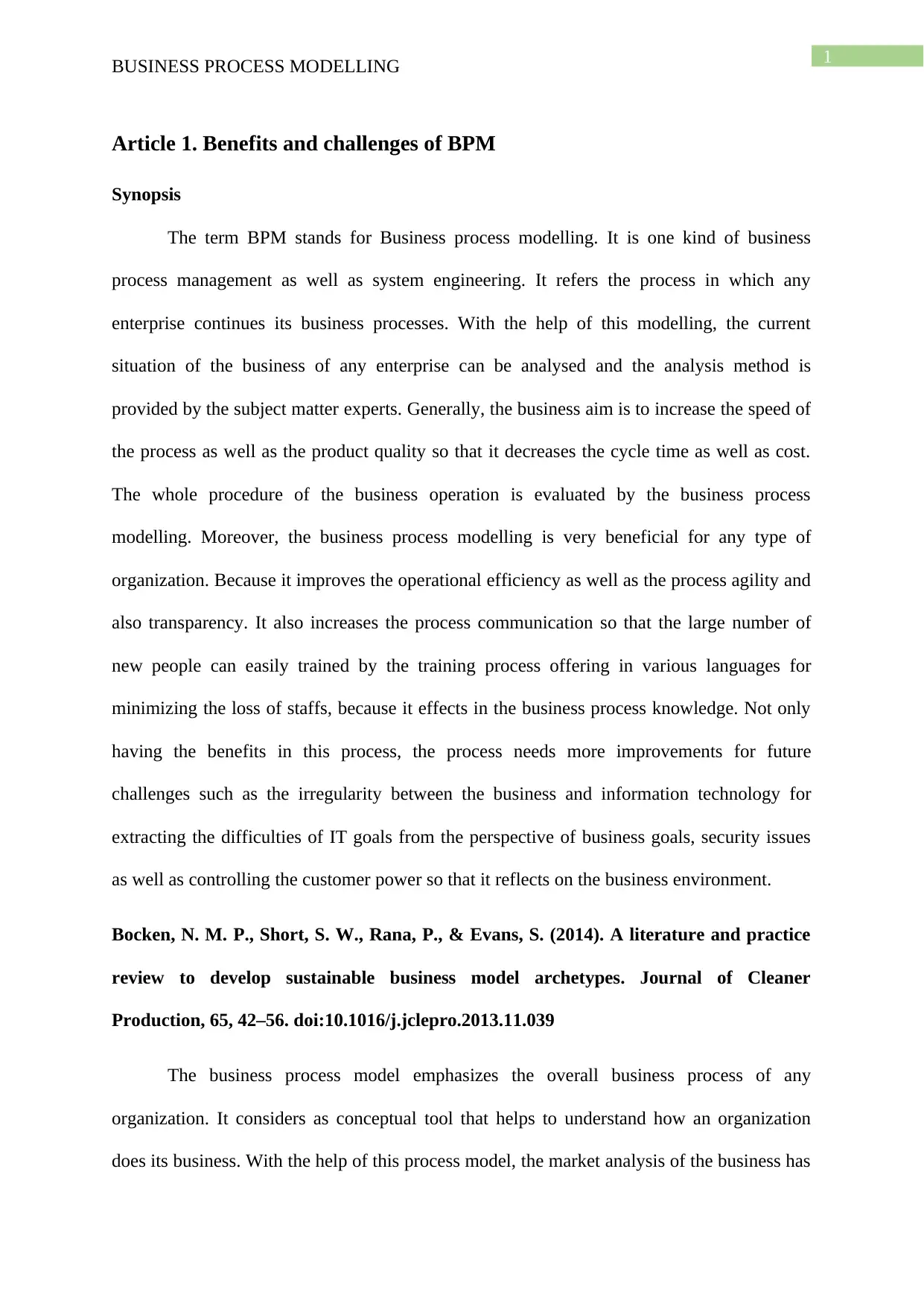
1
BUSINESS PROCESS MODELLING
Article 1. Benefits and challenges of BPM
Synopsis
The term BPM stands for Business process modelling. It is one kind of business
process management as well as system engineering. It refers the process in which any
enterprise continues its business processes. With the help of this modelling, the current
situation of the business of any enterprise can be analysed and the analysis method is
provided by the subject matter experts. Generally, the business aim is to increase the speed of
the process as well as the product quality so that it decreases the cycle time as well as cost.
The whole procedure of the business operation is evaluated by the business process
modelling. Moreover, the business process modelling is very beneficial for any type of
organization. Because it improves the operational efficiency as well as the process agility and
also transparency. It also increases the process communication so that the large number of
new people can easily trained by the training process offering in various languages for
minimizing the loss of staffs, because it effects in the business process knowledge. Not only
having the benefits in this process, the process needs more improvements for future
challenges such as the irregularity between the business and information technology for
extracting the difficulties of IT goals from the perspective of business goals, security issues
as well as controlling the customer power so that it reflects on the business environment.
Bocken, N. M. P., Short, S. W., Rana, P., & Evans, S. (2014). A literature and practice
review to develop sustainable business model archetypes. Journal of Cleaner
Production, 65, 42–56. doi:10.1016/j.jclepro.2013.11.039
The business process model emphasizes the overall business process of any
organization. It considers as conceptual tool that helps to understand how an organization
does its business. With the help of this process model, the market analysis of the business has
BUSINESS PROCESS MODELLING
Article 1. Benefits and challenges of BPM
Synopsis
The term BPM stands for Business process modelling. It is one kind of business
process management as well as system engineering. It refers the process in which any
enterprise continues its business processes. With the help of this modelling, the current
situation of the business of any enterprise can be analysed and the analysis method is
provided by the subject matter experts. Generally, the business aim is to increase the speed of
the process as well as the product quality so that it decreases the cycle time as well as cost.
The whole procedure of the business operation is evaluated by the business process
modelling. Moreover, the business process modelling is very beneficial for any type of
organization. Because it improves the operational efficiency as well as the process agility and
also transparency. It also increases the process communication so that the large number of
new people can easily trained by the training process offering in various languages for
minimizing the loss of staffs, because it effects in the business process knowledge. Not only
having the benefits in this process, the process needs more improvements for future
challenges such as the irregularity between the business and information technology for
extracting the difficulties of IT goals from the perspective of business goals, security issues
as well as controlling the customer power so that it reflects on the business environment.
Bocken, N. M. P., Short, S. W., Rana, P., & Evans, S. (2014). A literature and practice
review to develop sustainable business model archetypes. Journal of Cleaner
Production, 65, 42–56. doi:10.1016/j.jclepro.2013.11.039
The business process model emphasizes the overall business process of any
organization. It considers as conceptual tool that helps to understand how an organization
does its business. With the help of this process model, the market analysis of the business has
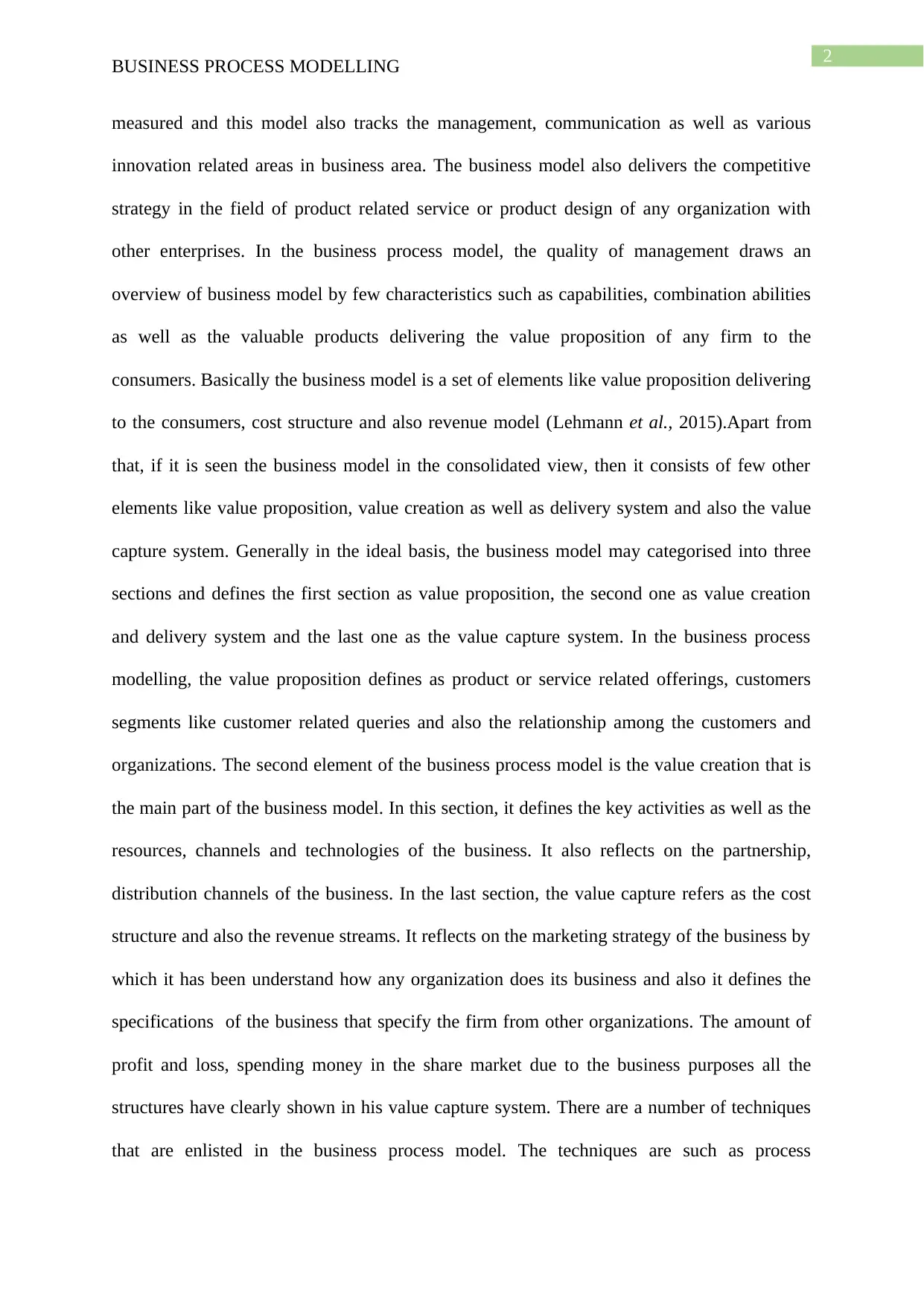
2
BUSINESS PROCESS MODELLING
measured and this model also tracks the management, communication as well as various
innovation related areas in business area. The business model also delivers the competitive
strategy in the field of product related service or product design of any organization with
other enterprises. In the business process model, the quality of management draws an
overview of business model by few characteristics such as capabilities, combination abilities
as well as the valuable products delivering the value proposition of any firm to the
consumers. Basically the business model is a set of elements like value proposition delivering
to the consumers, cost structure and also revenue model (Lehmann et al., 2015).Apart from
that, if it is seen the business model in the consolidated view, then it consists of few other
elements like value proposition, value creation as well as delivery system and also the value
capture system. Generally in the ideal basis, the business model may categorised into three
sections and defines the first section as value proposition, the second one as value creation
and delivery system and the last one as the value capture system. In the business process
modelling, the value proposition defines as product or service related offerings, customers
segments like customer related queries and also the relationship among the customers and
organizations. The second element of the business process model is the value creation that is
the main part of the business model. In this section, it defines the key activities as well as the
resources, channels and technologies of the business. It also reflects on the partnership,
distribution channels of the business. In the last section, the value capture refers as the cost
structure and also the revenue streams. It reflects on the marketing strategy of the business by
which it has been understand how any organization does its business and also it defines the
specifications of the business that specify the firm from other organizations. The amount of
profit and loss, spending money in the share market due to the business purposes all the
structures have clearly shown in his value capture system. There are a number of techniques
that are enlisted in the business process model. The techniques are such as process
BUSINESS PROCESS MODELLING
measured and this model also tracks the management, communication as well as various
innovation related areas in business area. The business model also delivers the competitive
strategy in the field of product related service or product design of any organization with
other enterprises. In the business process model, the quality of management draws an
overview of business model by few characteristics such as capabilities, combination abilities
as well as the valuable products delivering the value proposition of any firm to the
consumers. Basically the business model is a set of elements like value proposition delivering
to the consumers, cost structure and also revenue model (Lehmann et al., 2015).Apart from
that, if it is seen the business model in the consolidated view, then it consists of few other
elements like value proposition, value creation as well as delivery system and also the value
capture system. Generally in the ideal basis, the business model may categorised into three
sections and defines the first section as value proposition, the second one as value creation
and delivery system and the last one as the value capture system. In the business process
modelling, the value proposition defines as product or service related offerings, customers
segments like customer related queries and also the relationship among the customers and
organizations. The second element of the business process model is the value creation that is
the main part of the business model. In this section, it defines the key activities as well as the
resources, channels and technologies of the business. It also reflects on the partnership,
distribution channels of the business. In the last section, the value capture refers as the cost
structure and also the revenue streams. It reflects on the marketing strategy of the business by
which it has been understand how any organization does its business and also it defines the
specifications of the business that specify the firm from other organizations. The amount of
profit and loss, spending money in the share market due to the business purposes all the
structures have clearly shown in his value capture system. There are a number of techniques
that are enlisted in the business process model. The techniques are such as process
⊘ This is a preview!⊘
Do you want full access?
Subscribe today to unlock all pages.

Trusted by 1+ million students worldwide
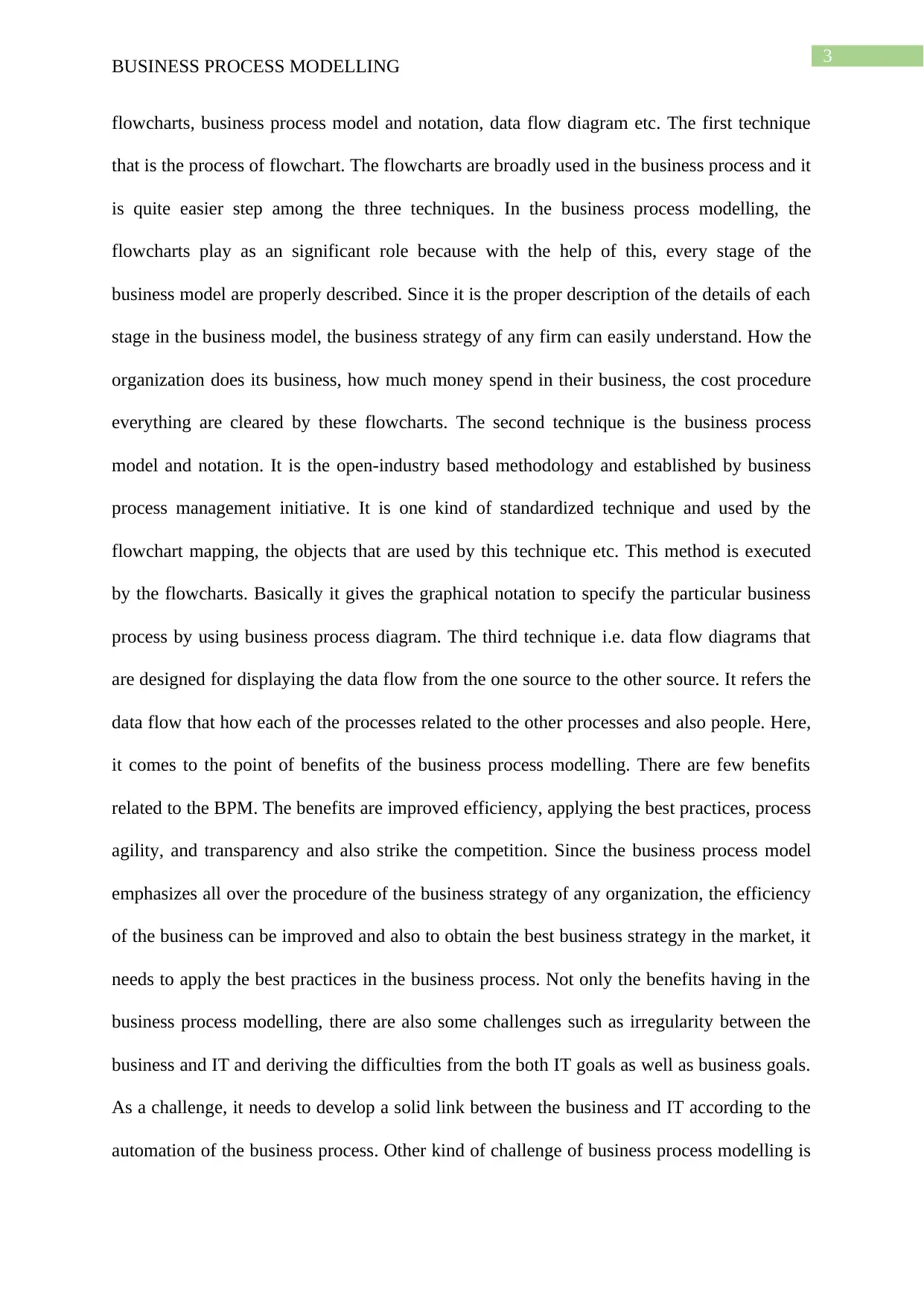
3
BUSINESS PROCESS MODELLING
flowcharts, business process model and notation, data flow diagram etc. The first technique
that is the process of flowchart. The flowcharts are broadly used in the business process and it
is quite easier step among the three techniques. In the business process modelling, the
flowcharts play as an significant role because with the help of this, every stage of the
business model are properly described. Since it is the proper description of the details of each
stage in the business model, the business strategy of any firm can easily understand. How the
organization does its business, how much money spend in their business, the cost procedure
everything are cleared by these flowcharts. The second technique is the business process
model and notation. It is the open-industry based methodology and established by business
process management initiative. It is one kind of standardized technique and used by the
flowchart mapping, the objects that are used by this technique etc. This method is executed
by the flowcharts. Basically it gives the graphical notation to specify the particular business
process by using business process diagram. The third technique i.e. data flow diagrams that
are designed for displaying the data flow from the one source to the other source. It refers the
data flow that how each of the processes related to the other processes and also people. Here,
it comes to the point of benefits of the business process modelling. There are few benefits
related to the BPM. The benefits are improved efficiency, applying the best practices, process
agility, and transparency and also strike the competition. Since the business process model
emphasizes all over the procedure of the business strategy of any organization, the efficiency
of the business can be improved and also to obtain the best business strategy in the market, it
needs to apply the best practices in the business process. Not only the benefits having in the
business process modelling, there are also some challenges such as irregularity between the
business and IT and deriving the difficulties from the both IT goals as well as business goals.
As a challenge, it needs to develop a solid link between the business and IT according to the
automation of the business process. Other kind of challenge of business process modelling is
BUSINESS PROCESS MODELLING
flowcharts, business process model and notation, data flow diagram etc. The first technique
that is the process of flowchart. The flowcharts are broadly used in the business process and it
is quite easier step among the three techniques. In the business process modelling, the
flowcharts play as an significant role because with the help of this, every stage of the
business model are properly described. Since it is the proper description of the details of each
stage in the business model, the business strategy of any firm can easily understand. How the
organization does its business, how much money spend in their business, the cost procedure
everything are cleared by these flowcharts. The second technique is the business process
model and notation. It is the open-industry based methodology and established by business
process management initiative. It is one kind of standardized technique and used by the
flowchart mapping, the objects that are used by this technique etc. This method is executed
by the flowcharts. Basically it gives the graphical notation to specify the particular business
process by using business process diagram. The third technique i.e. data flow diagrams that
are designed for displaying the data flow from the one source to the other source. It refers the
data flow that how each of the processes related to the other processes and also people. Here,
it comes to the point of benefits of the business process modelling. There are few benefits
related to the BPM. The benefits are improved efficiency, applying the best practices, process
agility, and transparency and also strike the competition. Since the business process model
emphasizes all over the procedure of the business strategy of any organization, the efficiency
of the business can be improved and also to obtain the best business strategy in the market, it
needs to apply the best practices in the business process. Not only the benefits having in the
business process modelling, there are also some challenges such as irregularity between the
business and IT and deriving the difficulties from the both IT goals as well as business goals.
As a challenge, it needs to develop a solid link between the business and IT according to the
automation of the business process. Other kind of challenge of business process modelling is
Paraphrase This Document
Need a fresh take? Get an instant paraphrase of this document with our AI Paraphraser
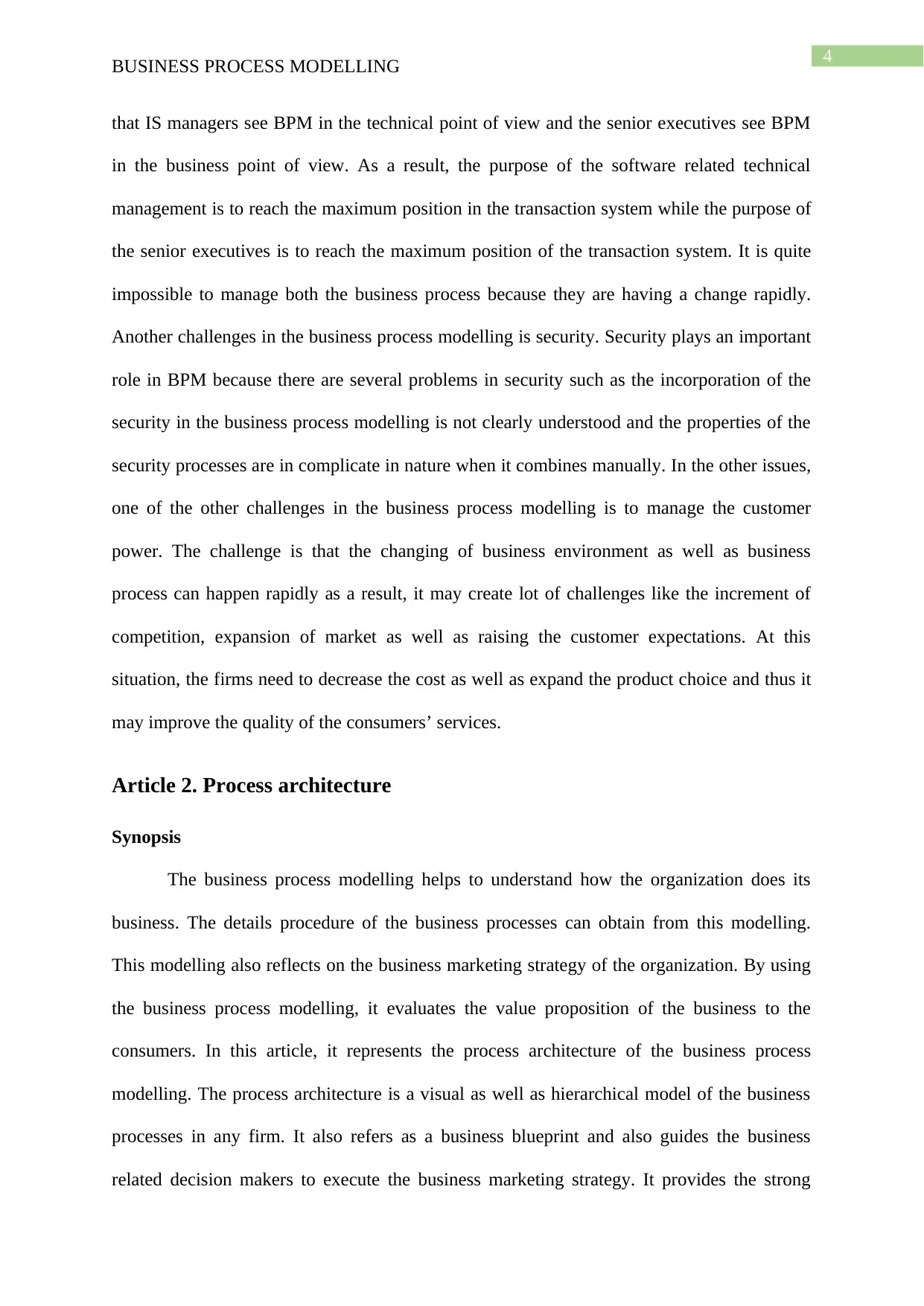
4
BUSINESS PROCESS MODELLING
that IS managers see BPM in the technical point of view and the senior executives see BPM
in the business point of view. As a result, the purpose of the software related technical
management is to reach the maximum position in the transaction system while the purpose of
the senior executives is to reach the maximum position of the transaction system. It is quite
impossible to manage both the business process because they are having a change rapidly.
Another challenges in the business process modelling is security. Security plays an important
role in BPM because there are several problems in security such as the incorporation of the
security in the business process modelling is not clearly understood and the properties of the
security processes are in complicate in nature when it combines manually. In the other issues,
one of the other challenges in the business process modelling is to manage the customer
power. The challenge is that the changing of business environment as well as business
process can happen rapidly as a result, it may create lot of challenges like the increment of
competition, expansion of market as well as raising the customer expectations. At this
situation, the firms need to decrease the cost as well as expand the product choice and thus it
may improve the quality of the consumers’ services.
Article 2. Process architecture
Synopsis
The business process modelling helps to understand how the organization does its
business. The details procedure of the business processes can obtain from this modelling.
This modelling also reflects on the business marketing strategy of the organization. By using
the business process modelling, it evaluates the value proposition of the business to the
consumers. In this article, it represents the process architecture of the business process
modelling. The process architecture is a visual as well as hierarchical model of the business
processes in any firm. It also refers as a business blueprint and also guides the business
related decision makers to execute the business marketing strategy. It provides the strong
BUSINESS PROCESS MODELLING
that IS managers see BPM in the technical point of view and the senior executives see BPM
in the business point of view. As a result, the purpose of the software related technical
management is to reach the maximum position in the transaction system while the purpose of
the senior executives is to reach the maximum position of the transaction system. It is quite
impossible to manage both the business process because they are having a change rapidly.
Another challenges in the business process modelling is security. Security plays an important
role in BPM because there are several problems in security such as the incorporation of the
security in the business process modelling is not clearly understood and the properties of the
security processes are in complicate in nature when it combines manually. In the other issues,
one of the other challenges in the business process modelling is to manage the customer
power. The challenge is that the changing of business environment as well as business
process can happen rapidly as a result, it may create lot of challenges like the increment of
competition, expansion of market as well as raising the customer expectations. At this
situation, the firms need to decrease the cost as well as expand the product choice and thus it
may improve the quality of the consumers’ services.
Article 2. Process architecture
Synopsis
The business process modelling helps to understand how the organization does its
business. The details procedure of the business processes can obtain from this modelling.
This modelling also reflects on the business marketing strategy of the organization. By using
the business process modelling, it evaluates the value proposition of the business to the
consumers. In this article, it represents the process architecture of the business process
modelling. The process architecture is a visual as well as hierarchical model of the business
processes in any firm. It also refers as a business blueprint and also guides the business
related decision makers to execute the business marketing strategy. It provides the strong
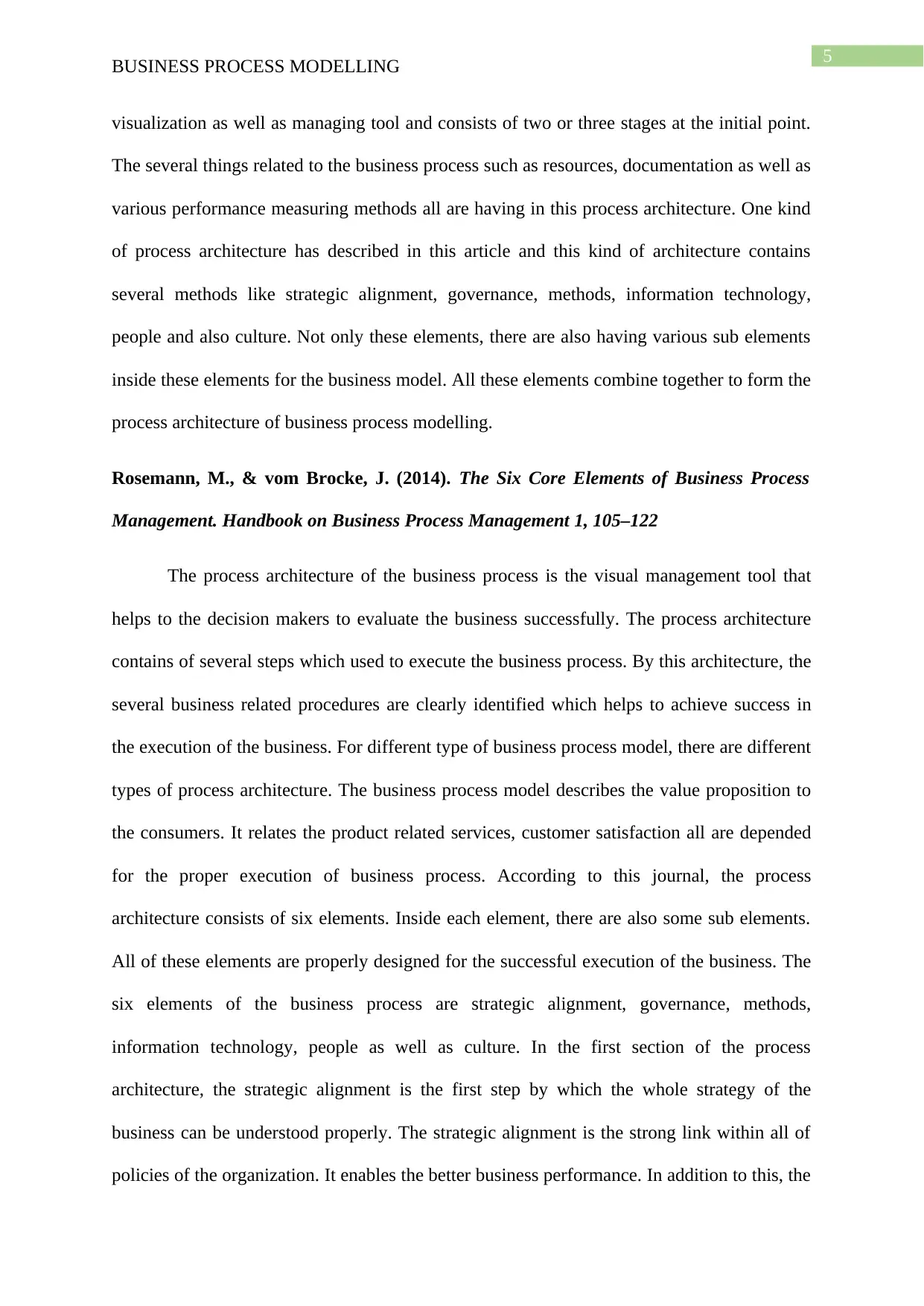
5
BUSINESS PROCESS MODELLING
visualization as well as managing tool and consists of two or three stages at the initial point.
The several things related to the business process such as resources, documentation as well as
various performance measuring methods all are having in this process architecture. One kind
of process architecture has described in this article and this kind of architecture contains
several methods like strategic alignment, governance, methods, information technology,
people and also culture. Not only these elements, there are also having various sub elements
inside these elements for the business model. All these elements combine together to form the
process architecture of business process modelling.
Rosemann, M., & vom Brocke, J. (2014). The Six Core Elements of Business Process
Management. Handbook on Business Process Management 1, 105–122
The process architecture of the business process is the visual management tool that
helps to the decision makers to evaluate the business successfully. The process architecture
contains of several steps which used to execute the business process. By this architecture, the
several business related procedures are clearly identified which helps to achieve success in
the execution of the business. For different type of business process model, there are different
types of process architecture. The business process model describes the value proposition to
the consumers. It relates the product related services, customer satisfaction all are depended
for the proper execution of business process. According to this journal, the process
architecture consists of six elements. Inside each element, there are also some sub elements.
All of these elements are properly designed for the successful execution of the business. The
six elements of the business process are strategic alignment, governance, methods,
information technology, people as well as culture. In the first section of the process
architecture, the strategic alignment is the first step by which the whole strategy of the
business can be understood properly. The strategic alignment is the strong link within all of
policies of the organization. It enables the better business performance. In addition to this, the
BUSINESS PROCESS MODELLING
visualization as well as managing tool and consists of two or three stages at the initial point.
The several things related to the business process such as resources, documentation as well as
various performance measuring methods all are having in this process architecture. One kind
of process architecture has described in this article and this kind of architecture contains
several methods like strategic alignment, governance, methods, information technology,
people and also culture. Not only these elements, there are also having various sub elements
inside these elements for the business model. All these elements combine together to form the
process architecture of business process modelling.
Rosemann, M., & vom Brocke, J. (2014). The Six Core Elements of Business Process
Management. Handbook on Business Process Management 1, 105–122
The process architecture of the business process is the visual management tool that
helps to the decision makers to evaluate the business successfully. The process architecture
contains of several steps which used to execute the business process. By this architecture, the
several business related procedures are clearly identified which helps to achieve success in
the execution of the business. For different type of business process model, there are different
types of process architecture. The business process model describes the value proposition to
the consumers. It relates the product related services, customer satisfaction all are depended
for the proper execution of business process. According to this journal, the process
architecture consists of six elements. Inside each element, there are also some sub elements.
All of these elements are properly designed for the successful execution of the business. The
six elements of the business process are strategic alignment, governance, methods,
information technology, people as well as culture. In the first section of the process
architecture, the strategic alignment is the first step by which the whole strategy of the
business can be understood properly. The strategic alignment is the strong link within all of
policies of the organization. It enables the better business performance. In addition to this, the
⊘ This is a preview!⊘
Do you want full access?
Subscribe today to unlock all pages.

Trusted by 1+ million students worldwide
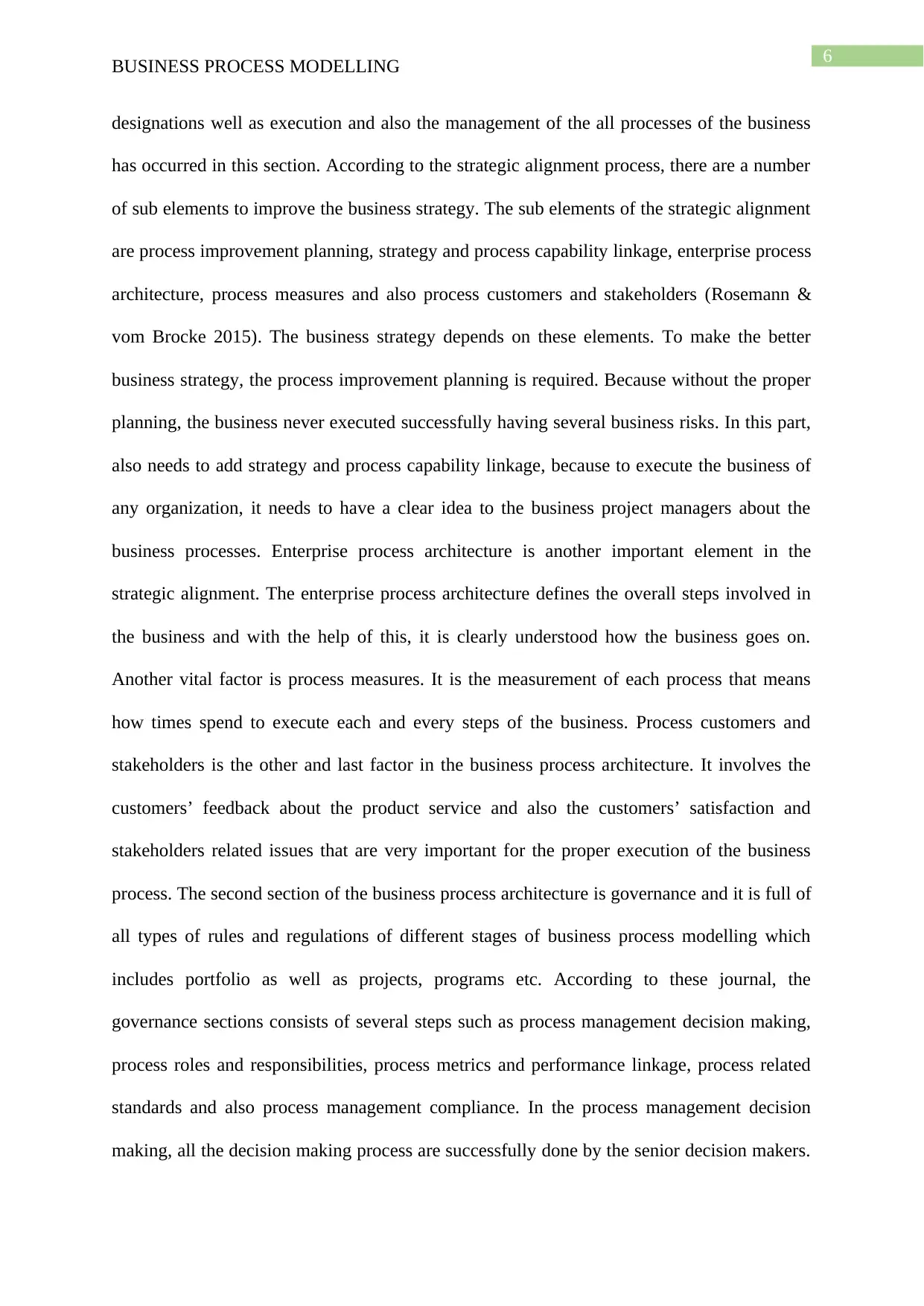
6
BUSINESS PROCESS MODELLING
designations well as execution and also the management of the all processes of the business
has occurred in this section. According to the strategic alignment process, there are a number
of sub elements to improve the business strategy. The sub elements of the strategic alignment
are process improvement planning, strategy and process capability linkage, enterprise process
architecture, process measures and also process customers and stakeholders (Rosemann &
vom Brocke 2015). The business strategy depends on these elements. To make the better
business strategy, the process improvement planning is required. Because without the proper
planning, the business never executed successfully having several business risks. In this part,
also needs to add strategy and process capability linkage, because to execute the business of
any organization, it needs to have a clear idea to the business project managers about the
business processes. Enterprise process architecture is another important element in the
strategic alignment. The enterprise process architecture defines the overall steps involved in
the business and with the help of this, it is clearly understood how the business goes on.
Another vital factor is process measures. It is the measurement of each process that means
how times spend to execute each and every steps of the business. Process customers and
stakeholders is the other and last factor in the business process architecture. It involves the
customers’ feedback about the product service and also the customers’ satisfaction and
stakeholders related issues that are very important for the proper execution of the business
process. The second section of the business process architecture is governance and it is full of
all types of rules and regulations of different stages of business process modelling which
includes portfolio as well as projects, programs etc. According to these journal, the
governance sections consists of several steps such as process management decision making,
process roles and responsibilities, process metrics and performance linkage, process related
standards and also process management compliance. In the process management decision
making, all the decision making process are successfully done by the senior decision makers.
BUSINESS PROCESS MODELLING
designations well as execution and also the management of the all processes of the business
has occurred in this section. According to the strategic alignment process, there are a number
of sub elements to improve the business strategy. The sub elements of the strategic alignment
are process improvement planning, strategy and process capability linkage, enterprise process
architecture, process measures and also process customers and stakeholders (Rosemann &
vom Brocke 2015). The business strategy depends on these elements. To make the better
business strategy, the process improvement planning is required. Because without the proper
planning, the business never executed successfully having several business risks. In this part,
also needs to add strategy and process capability linkage, because to execute the business of
any organization, it needs to have a clear idea to the business project managers about the
business processes. Enterprise process architecture is another important element in the
strategic alignment. The enterprise process architecture defines the overall steps involved in
the business and with the help of this, it is clearly understood how the business goes on.
Another vital factor is process measures. It is the measurement of each process that means
how times spend to execute each and every steps of the business. Process customers and
stakeholders is the other and last factor in the business process architecture. It involves the
customers’ feedback about the product service and also the customers’ satisfaction and
stakeholders related issues that are very important for the proper execution of the business
process. The second section of the business process architecture is governance and it is full of
all types of rules and regulations of different stages of business process modelling which
includes portfolio as well as projects, programs etc. According to these journal, the
governance sections consists of several steps such as process management decision making,
process roles and responsibilities, process metrics and performance linkage, process related
standards and also process management compliance. In the process management decision
making, all the decision making process are successfully done by the senior decision makers.
Paraphrase This Document
Need a fresh take? Get an instant paraphrase of this document with our AI Paraphraser
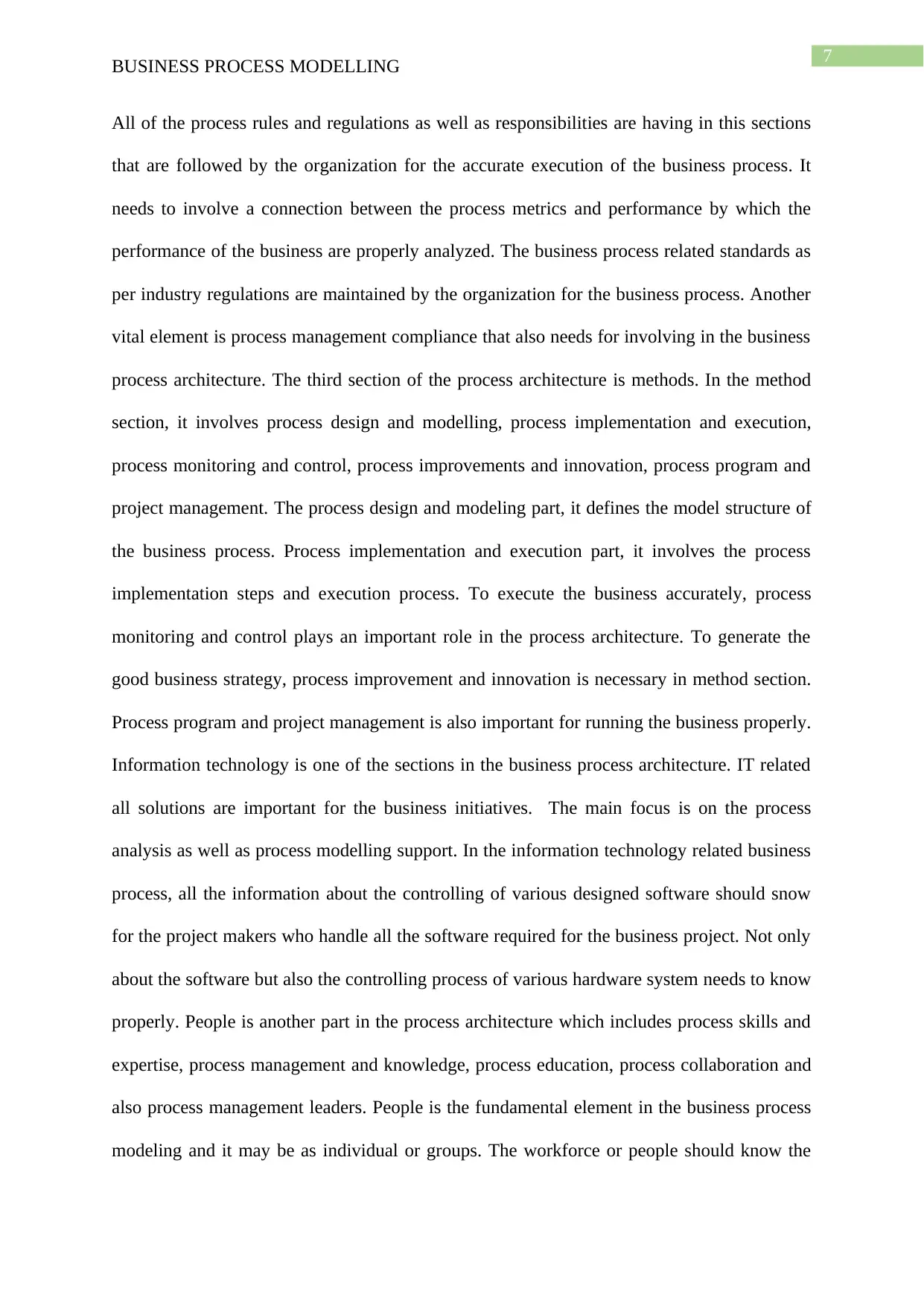
7
BUSINESS PROCESS MODELLING
All of the process rules and regulations as well as responsibilities are having in this sections
that are followed by the organization for the accurate execution of the business process. It
needs to involve a connection between the process metrics and performance by which the
performance of the business are properly analyzed. The business process related standards as
per industry regulations are maintained by the organization for the business process. Another
vital element is process management compliance that also needs for involving in the business
process architecture. The third section of the process architecture is methods. In the method
section, it involves process design and modelling, process implementation and execution,
process monitoring and control, process improvements and innovation, process program and
project management. The process design and modeling part, it defines the model structure of
the business process. Process implementation and execution part, it involves the process
implementation steps and execution process. To execute the business accurately, process
monitoring and control plays an important role in the process architecture. To generate the
good business strategy, process improvement and innovation is necessary in method section.
Process program and project management is also important for running the business properly.
Information technology is one of the sections in the business process architecture. IT related
all solutions are important for the business initiatives. The main focus is on the process
analysis as well as process modelling support. In the information technology related business
process, all the information about the controlling of various designed software should snow
for the project makers who handle all the software required for the business project. Not only
about the software but also the controlling process of various hardware system needs to know
properly. People is another part in the process architecture which includes process skills and
expertise, process management and knowledge, process education, process collaboration and
also process management leaders. People is the fundamental element in the business process
modeling and it may be as individual or groups. The workforce or people should know the
BUSINESS PROCESS MODELLING
All of the process rules and regulations as well as responsibilities are having in this sections
that are followed by the organization for the accurate execution of the business process. It
needs to involve a connection between the process metrics and performance by which the
performance of the business are properly analyzed. The business process related standards as
per industry regulations are maintained by the organization for the business process. Another
vital element is process management compliance that also needs for involving in the business
process architecture. The third section of the process architecture is methods. In the method
section, it involves process design and modelling, process implementation and execution,
process monitoring and control, process improvements and innovation, process program and
project management. The process design and modeling part, it defines the model structure of
the business process. Process implementation and execution part, it involves the process
implementation steps and execution process. To execute the business accurately, process
monitoring and control plays an important role in the process architecture. To generate the
good business strategy, process improvement and innovation is necessary in method section.
Process program and project management is also important for running the business properly.
Information technology is one of the sections in the business process architecture. IT related
all solutions are important for the business initiatives. The main focus is on the process
analysis as well as process modelling support. In the information technology related business
process, all the information about the controlling of various designed software should snow
for the project makers who handle all the software required for the business project. Not only
about the software but also the controlling process of various hardware system needs to know
properly. People is another part in the process architecture which includes process skills and
expertise, process management and knowledge, process education, process collaboration and
also process management leaders. People is the fundamental element in the business process
modeling and it may be as individual or groups. The workforce or people should know the
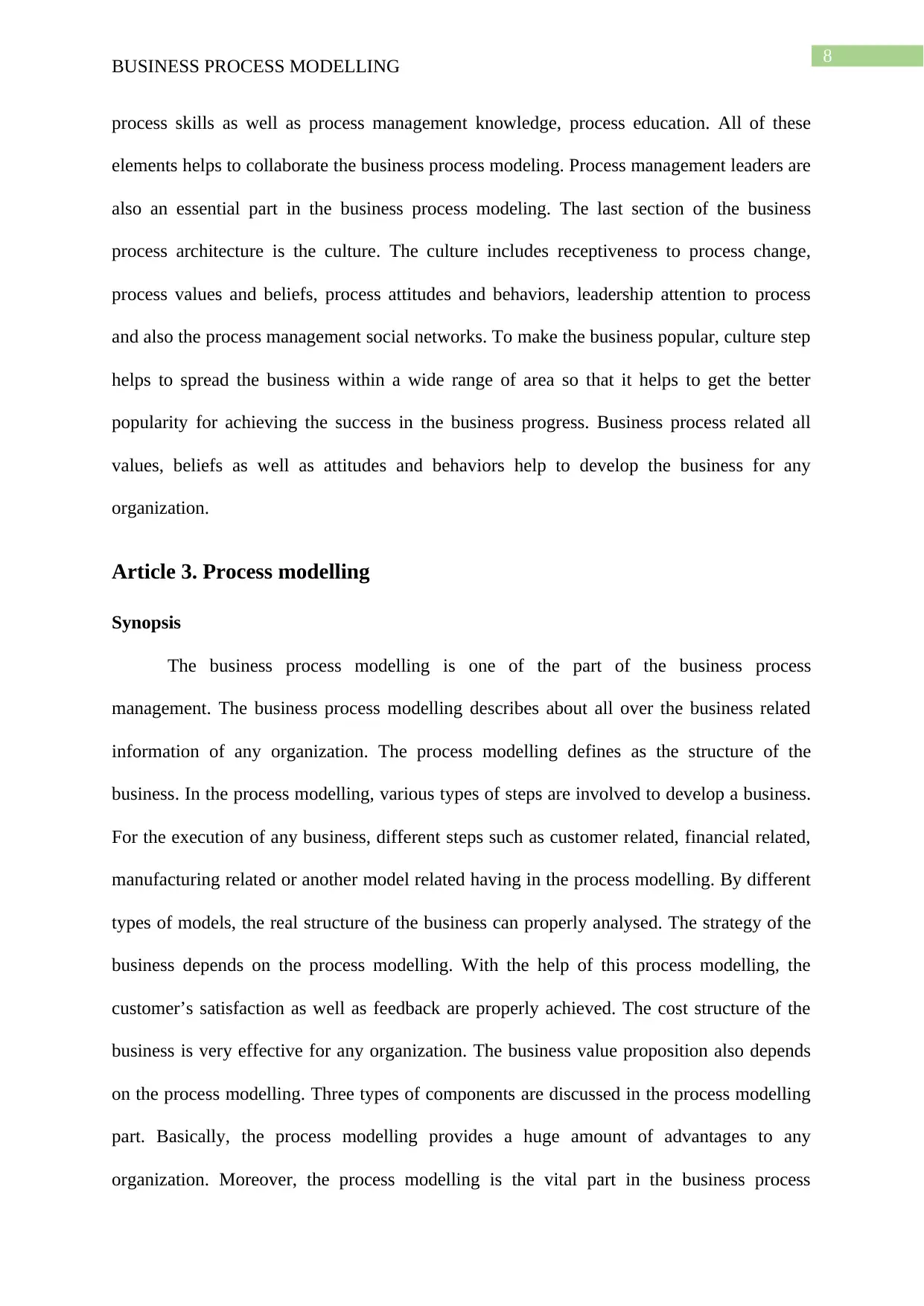
8
BUSINESS PROCESS MODELLING
process skills as well as process management knowledge, process education. All of these
elements helps to collaborate the business process modeling. Process management leaders are
also an essential part in the business process modeling. The last section of the business
process architecture is the culture. The culture includes receptiveness to process change,
process values and beliefs, process attitudes and behaviors, leadership attention to process
and also the process management social networks. To make the business popular, culture step
helps to spread the business within a wide range of area so that it helps to get the better
popularity for achieving the success in the business progress. Business process related all
values, beliefs as well as attitudes and behaviors help to develop the business for any
organization.
Article 3. Process modelling
Synopsis
The business process modelling is one of the part of the business process
management. The business process modelling describes about all over the business related
information of any organization. The process modelling defines as the structure of the
business. In the process modelling, various types of steps are involved to develop a business.
For the execution of any business, different steps such as customer related, financial related,
manufacturing related or another model related having in the process modelling. By different
types of models, the real structure of the business can properly analysed. The strategy of the
business depends on the process modelling. With the help of this process modelling, the
customer’s satisfaction as well as feedback are properly achieved. The cost structure of the
business is very effective for any organization. The business value proposition also depends
on the process modelling. Three types of components are discussed in the process modelling
part. Basically, the process modelling provides a huge amount of advantages to any
organization. Moreover, the process modelling is the vital part in the business process
BUSINESS PROCESS MODELLING
process skills as well as process management knowledge, process education. All of these
elements helps to collaborate the business process modeling. Process management leaders are
also an essential part in the business process modeling. The last section of the business
process architecture is the culture. The culture includes receptiveness to process change,
process values and beliefs, process attitudes and behaviors, leadership attention to process
and also the process management social networks. To make the business popular, culture step
helps to spread the business within a wide range of area so that it helps to get the better
popularity for achieving the success in the business progress. Business process related all
values, beliefs as well as attitudes and behaviors help to develop the business for any
organization.
Article 3. Process modelling
Synopsis
The business process modelling is one of the part of the business process
management. The business process modelling describes about all over the business related
information of any organization. The process modelling defines as the structure of the
business. In the process modelling, various types of steps are involved to develop a business.
For the execution of any business, different steps such as customer related, financial related,
manufacturing related or another model related having in the process modelling. By different
types of models, the real structure of the business can properly analysed. The strategy of the
business depends on the process modelling. With the help of this process modelling, the
customer’s satisfaction as well as feedback are properly achieved. The cost structure of the
business is very effective for any organization. The business value proposition also depends
on the process modelling. Three types of components are discussed in the process modelling
part. Basically, the process modelling provides a huge amount of advantages to any
organization. Moreover, the process modelling is the vital part in the business process
⊘ This is a preview!⊘
Do you want full access?
Subscribe today to unlock all pages.

Trusted by 1+ million students worldwide
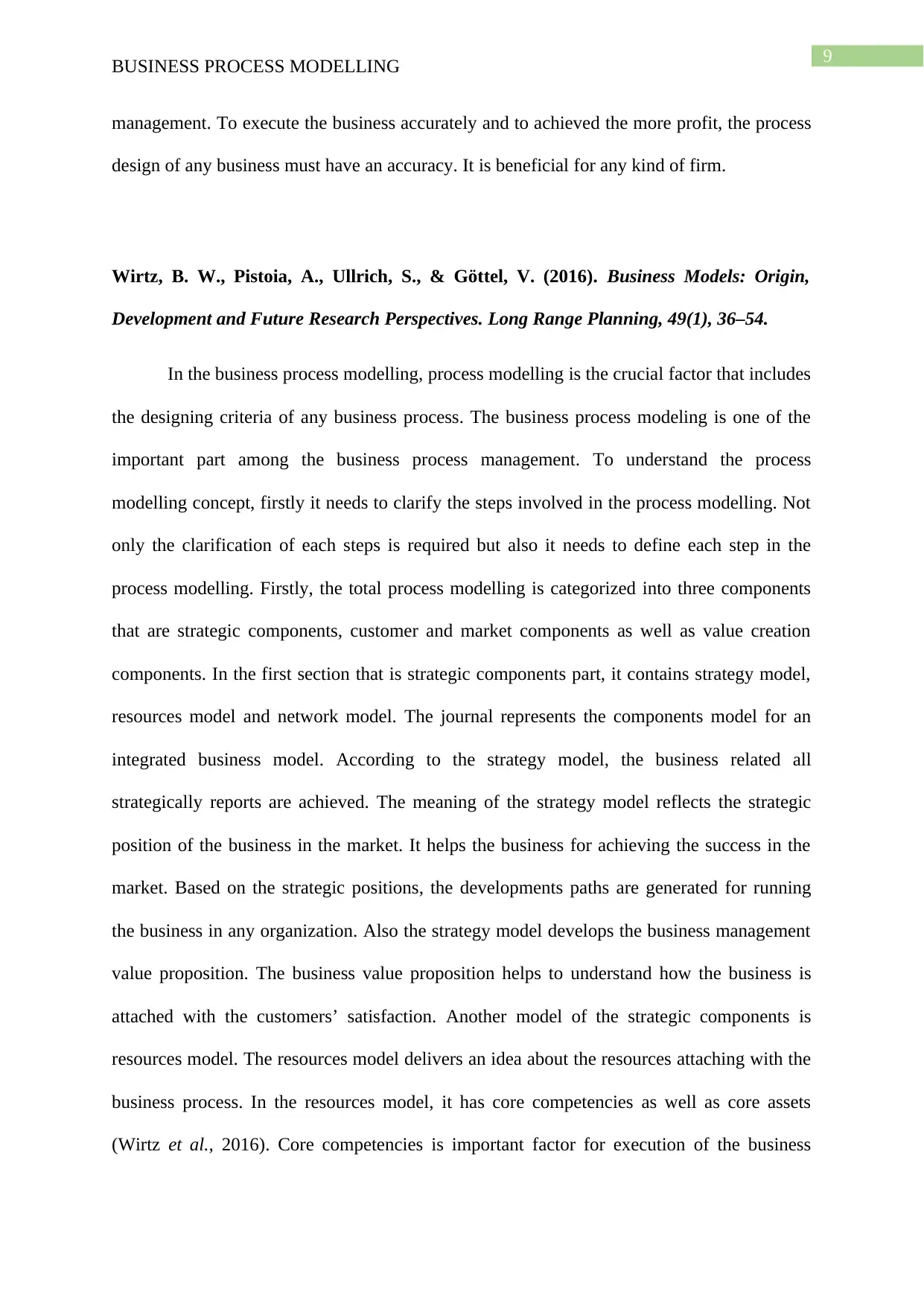
9
BUSINESS PROCESS MODELLING
management. To execute the business accurately and to achieved the more profit, the process
design of any business must have an accuracy. It is beneficial for any kind of firm.
Wirtz, B. W., Pistoia, A., Ullrich, S., & Göttel, V. (2016). Business Models: Origin,
Development and Future Research Perspectives. Long Range Planning, 49(1), 36–54.
In the business process modelling, process modelling is the crucial factor that includes
the designing criteria of any business process. The business process modeling is one of the
important part among the business process management. To understand the process
modelling concept, firstly it needs to clarify the steps involved in the process modelling. Not
only the clarification of each steps is required but also it needs to define each step in the
process modelling. Firstly, the total process modelling is categorized into three components
that are strategic components, customer and market components as well as value creation
components. In the first section that is strategic components part, it contains strategy model,
resources model and network model. The journal represents the components model for an
integrated business model. According to the strategy model, the business related all
strategically reports are achieved. The meaning of the strategy model reflects the strategic
position of the business in the market. It helps the business for achieving the success in the
market. Based on the strategic positions, the developments paths are generated for running
the business in any organization. Also the strategy model develops the business management
value proposition. The business value proposition helps to understand how the business is
attached with the customers’ satisfaction. Another model of the strategic components is
resources model. The resources model delivers an idea about the resources attaching with the
business process. In the resources model, it has core competencies as well as core assets
(Wirtz et al., 2016). Core competencies is important factor for execution of the business
BUSINESS PROCESS MODELLING
management. To execute the business accurately and to achieved the more profit, the process
design of any business must have an accuracy. It is beneficial for any kind of firm.
Wirtz, B. W., Pistoia, A., Ullrich, S., & Göttel, V. (2016). Business Models: Origin,
Development and Future Research Perspectives. Long Range Planning, 49(1), 36–54.
In the business process modelling, process modelling is the crucial factor that includes
the designing criteria of any business process. The business process modeling is one of the
important part among the business process management. To understand the process
modelling concept, firstly it needs to clarify the steps involved in the process modelling. Not
only the clarification of each steps is required but also it needs to define each step in the
process modelling. Firstly, the total process modelling is categorized into three components
that are strategic components, customer and market components as well as value creation
components. In the first section that is strategic components part, it contains strategy model,
resources model and network model. The journal represents the components model for an
integrated business model. According to the strategy model, the business related all
strategically reports are achieved. The meaning of the strategy model reflects the strategic
position of the business in the market. It helps the business for achieving the success in the
market. Based on the strategic positions, the developments paths are generated for running
the business in any organization. Also the strategy model develops the business management
value proposition. The business value proposition helps to understand how the business is
attached with the customers’ satisfaction. Another model of the strategic components is
resources model. The resources model delivers an idea about the resources attaching with the
business process. In the resources model, it has core competencies as well as core assets
(Wirtz et al., 2016). Core competencies is important factor for execution of the business
Paraphrase This Document
Need a fresh take? Get an instant paraphrase of this document with our AI Paraphraser
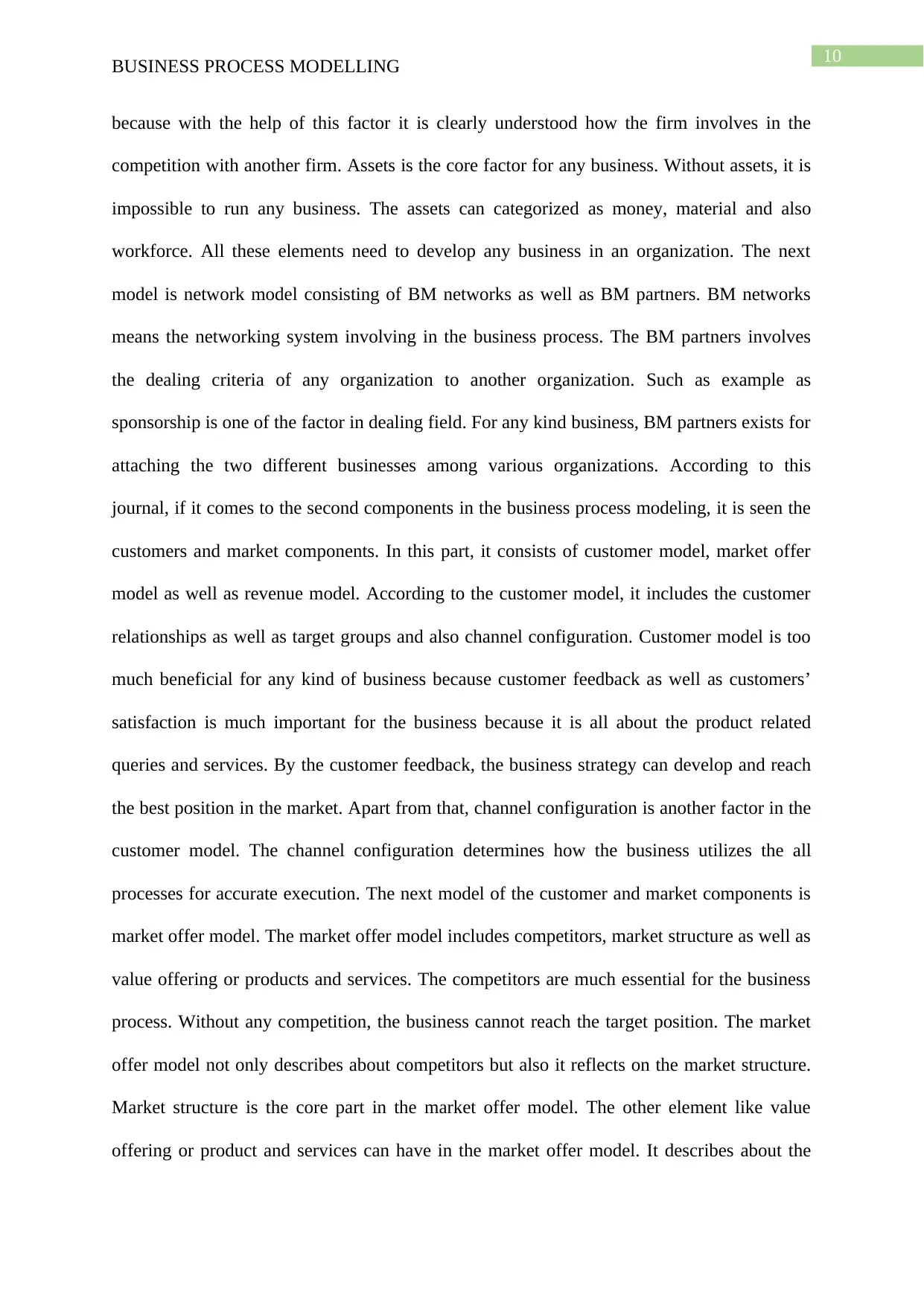
10
BUSINESS PROCESS MODELLING
because with the help of this factor it is clearly understood how the firm involves in the
competition with another firm. Assets is the core factor for any business. Without assets, it is
impossible to run any business. The assets can categorized as money, material and also
workforce. All these elements need to develop any business in an organization. The next
model is network model consisting of BM networks as well as BM partners. BM networks
means the networking system involving in the business process. The BM partners involves
the dealing criteria of any organization to another organization. Such as example as
sponsorship is one of the factor in dealing field. For any kind business, BM partners exists for
attaching the two different businesses among various organizations. According to this
journal, if it comes to the second components in the business process modeling, it is seen the
customers and market components. In this part, it consists of customer model, market offer
model as well as revenue model. According to the customer model, it includes the customer
relationships as well as target groups and also channel configuration. Customer model is too
much beneficial for any kind of business because customer feedback as well as customers’
satisfaction is much important for the business because it is all about the product related
queries and services. By the customer feedback, the business strategy can develop and reach
the best position in the market. Apart from that, channel configuration is another factor in the
customer model. The channel configuration determines how the business utilizes the all
processes for accurate execution. The next model of the customer and market components is
market offer model. The market offer model includes competitors, market structure as well as
value offering or products and services. The competitors are much essential for the business
process. Without any competition, the business cannot reach the target position. The market
offer model not only describes about competitors but also it reflects on the market structure.
Market structure is the core part in the market offer model. The other element like value
offering or product and services can have in the market offer model. It describes about the
BUSINESS PROCESS MODELLING
because with the help of this factor it is clearly understood how the firm involves in the
competition with another firm. Assets is the core factor for any business. Without assets, it is
impossible to run any business. The assets can categorized as money, material and also
workforce. All these elements need to develop any business in an organization. The next
model is network model consisting of BM networks as well as BM partners. BM networks
means the networking system involving in the business process. The BM partners involves
the dealing criteria of any organization to another organization. Such as example as
sponsorship is one of the factor in dealing field. For any kind business, BM partners exists for
attaching the two different businesses among various organizations. According to this
journal, if it comes to the second components in the business process modeling, it is seen the
customers and market components. In this part, it consists of customer model, market offer
model as well as revenue model. According to the customer model, it includes the customer
relationships as well as target groups and also channel configuration. Customer model is too
much beneficial for any kind of business because customer feedback as well as customers’
satisfaction is much important for the business because it is all about the product related
queries and services. By the customer feedback, the business strategy can develop and reach
the best position in the market. Apart from that, channel configuration is another factor in the
customer model. The channel configuration determines how the business utilizes the all
processes for accurate execution. The next model of the customer and market components is
market offer model. The market offer model includes competitors, market structure as well as
value offering or products and services. The competitors are much essential for the business
process. Without any competition, the business cannot reach the target position. The market
offer model not only describes about competitors but also it reflects on the market structure.
Market structure is the core part in the market offer model. The other element like value
offering or product and services can have in the market offer model. It describes about the
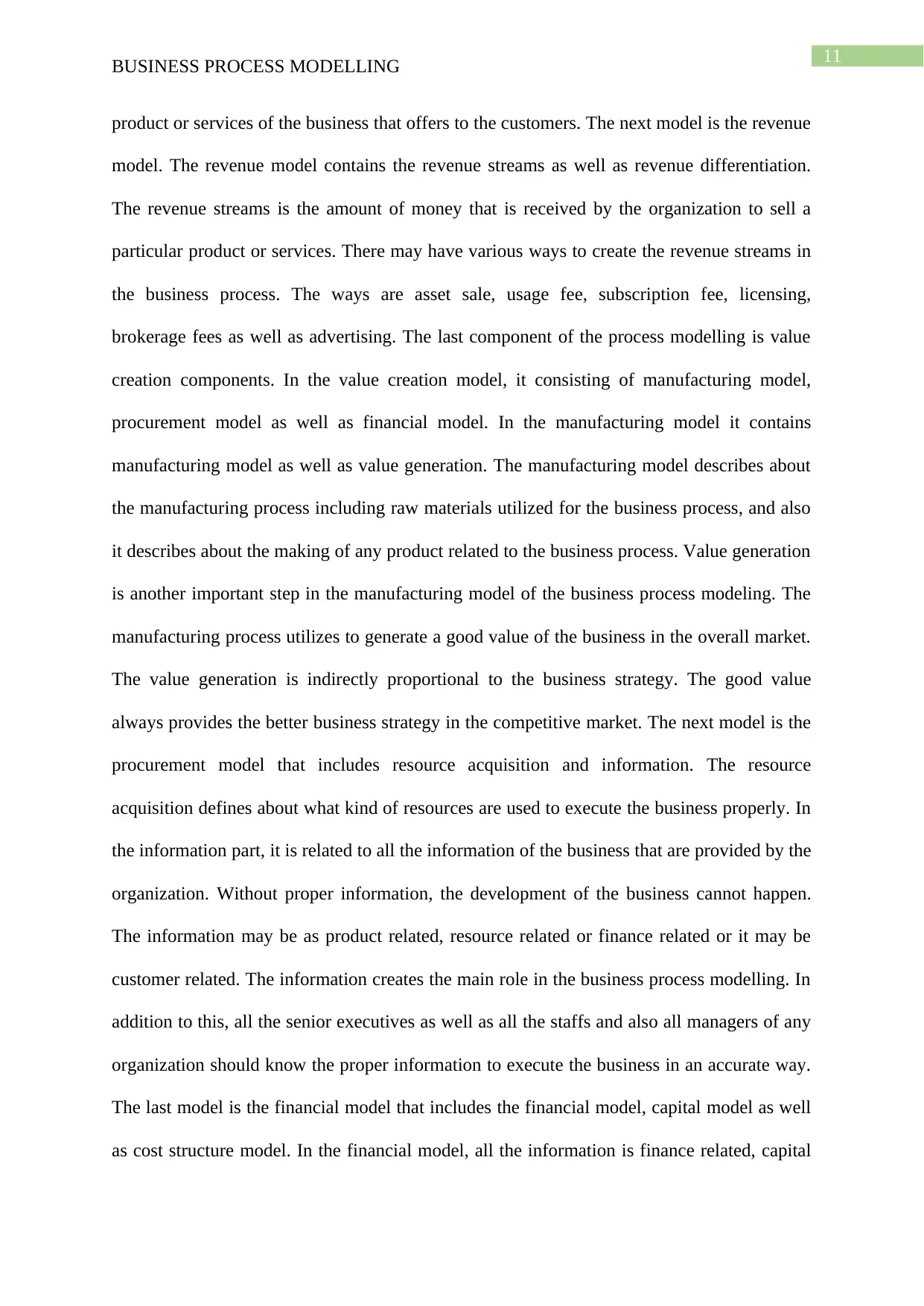
11
BUSINESS PROCESS MODELLING
product or services of the business that offers to the customers. The next model is the revenue
model. The revenue model contains the revenue streams as well as revenue differentiation.
The revenue streams is the amount of money that is received by the organization to sell a
particular product or services. There may have various ways to create the revenue streams in
the business process. The ways are asset sale, usage fee, subscription fee, licensing,
brokerage fees as well as advertising. The last component of the process modelling is value
creation components. In the value creation model, it consisting of manufacturing model,
procurement model as well as financial model. In the manufacturing model it contains
manufacturing model as well as value generation. The manufacturing model describes about
the manufacturing process including raw materials utilized for the business process, and also
it describes about the making of any product related to the business process. Value generation
is another important step in the manufacturing model of the business process modeling. The
manufacturing process utilizes to generate a good value of the business in the overall market.
The value generation is indirectly proportional to the business strategy. The good value
always provides the better business strategy in the competitive market. The next model is the
procurement model that includes resource acquisition and information. The resource
acquisition defines about what kind of resources are used to execute the business properly. In
the information part, it is related to all the information of the business that are provided by the
organization. Without proper information, the development of the business cannot happen.
The information may be as product related, resource related or finance related or it may be
customer related. The information creates the main role in the business process modelling. In
addition to this, all the senior executives as well as all the staffs and also all managers of any
organization should know the proper information to execute the business in an accurate way.
The last model is the financial model that includes the financial model, capital model as well
as cost structure model. In the financial model, all the information is finance related, capital
BUSINESS PROCESS MODELLING
product or services of the business that offers to the customers. The next model is the revenue
model. The revenue model contains the revenue streams as well as revenue differentiation.
The revenue streams is the amount of money that is received by the organization to sell a
particular product or services. There may have various ways to create the revenue streams in
the business process. The ways are asset sale, usage fee, subscription fee, licensing,
brokerage fees as well as advertising. The last component of the process modelling is value
creation components. In the value creation model, it consisting of manufacturing model,
procurement model as well as financial model. In the manufacturing model it contains
manufacturing model as well as value generation. The manufacturing model describes about
the manufacturing process including raw materials utilized for the business process, and also
it describes about the making of any product related to the business process. Value generation
is another important step in the manufacturing model of the business process modeling. The
manufacturing process utilizes to generate a good value of the business in the overall market.
The value generation is indirectly proportional to the business strategy. The good value
always provides the better business strategy in the competitive market. The next model is the
procurement model that includes resource acquisition and information. The resource
acquisition defines about what kind of resources are used to execute the business properly. In
the information part, it is related to all the information of the business that are provided by the
organization. Without proper information, the development of the business cannot happen.
The information may be as product related, resource related or finance related or it may be
customer related. The information creates the main role in the business process modelling. In
addition to this, all the senior executives as well as all the staffs and also all managers of any
organization should know the proper information to execute the business in an accurate way.
The last model is the financial model that includes the financial model, capital model as well
as cost structure model. In the financial model, all the information is finance related, capital
⊘ This is a preview!⊘
Do you want full access?
Subscribe today to unlock all pages.

Trusted by 1+ million students worldwide
1 out of 25
Related Documents
Your All-in-One AI-Powered Toolkit for Academic Success.
+13062052269
info@desklib.com
Available 24*7 on WhatsApp / Email
![[object Object]](/_next/static/media/star-bottom.7253800d.svg)
Unlock your academic potential
Copyright © 2020–2025 A2Z Services. All Rights Reserved. Developed and managed by ZUCOL.





